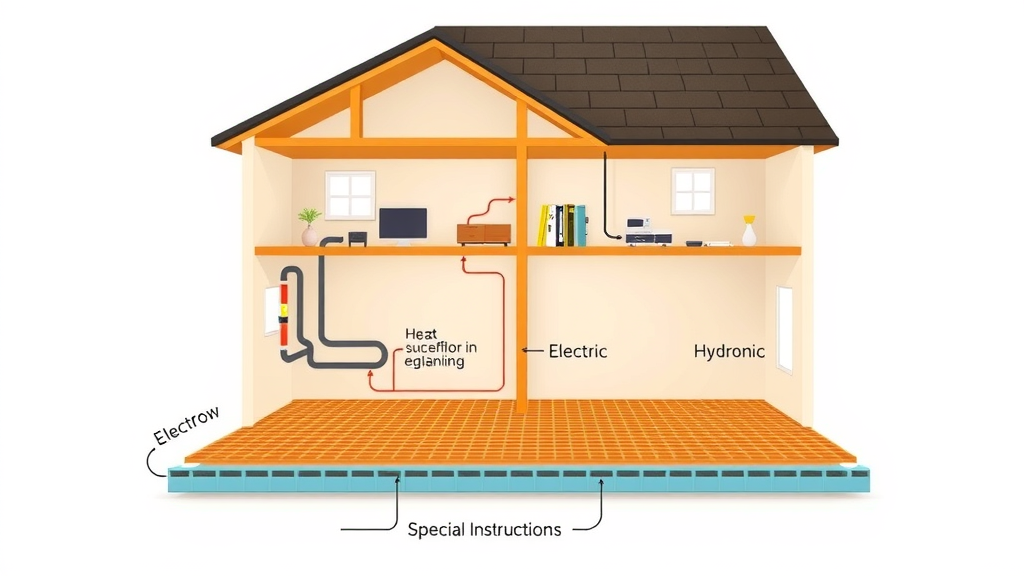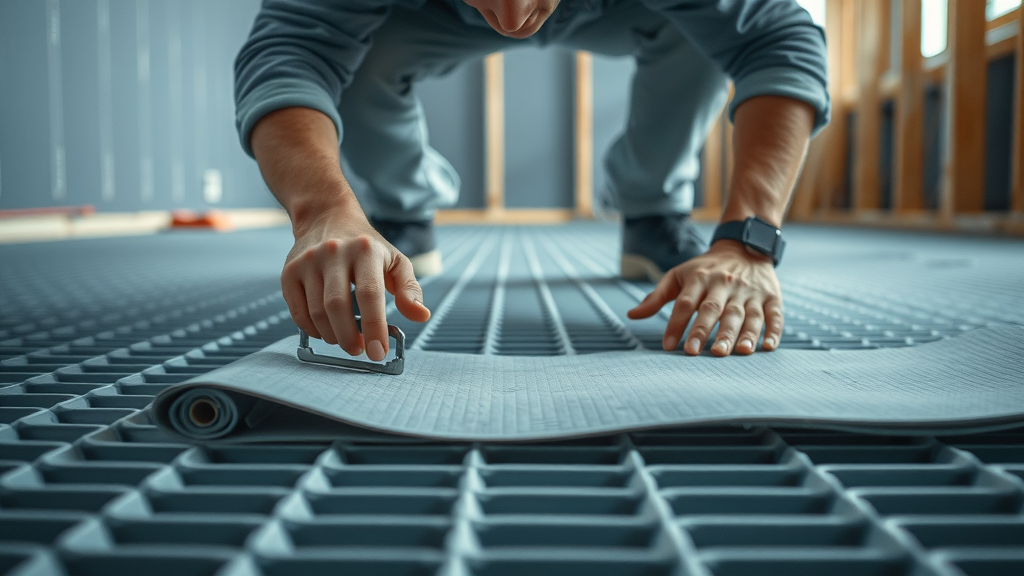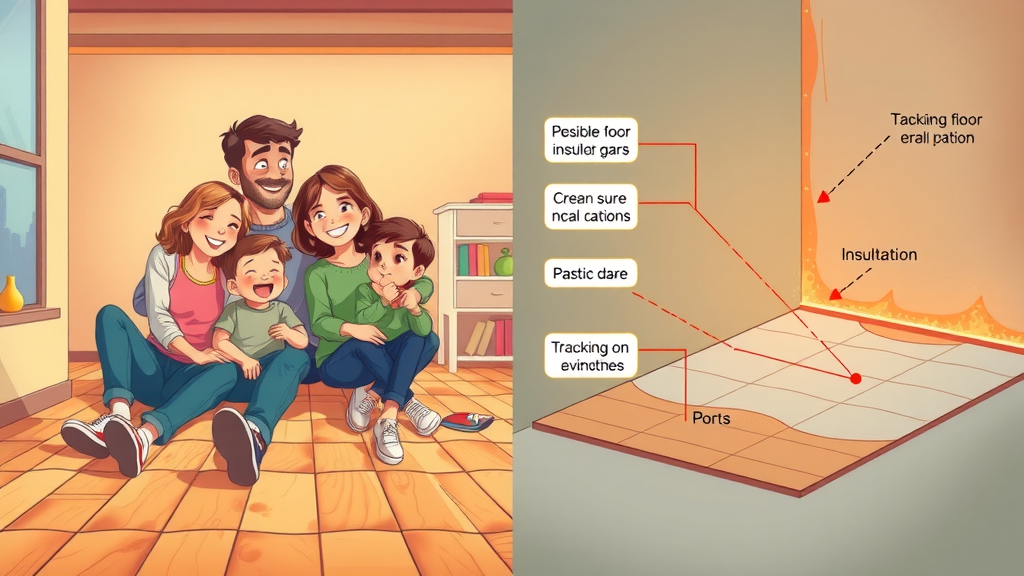Did you know that underfloor heating installation can reduce your energy usage by up to 15% compared to traditional radiators? Imagine stepping onto a gently warmed floor every morning instead of chilly tiles or wood flooring. As families around the globe embrace radiant floor heating for both comfort and efficiency, savvy homeowners like you are looking to make the switch. This guide delivers everything you need—from practical tips to expert advice—to ensure your floor heating installation is a success.
Discover Why Underfloor Heating Installation Is Rapidly Becoming the Preferred Choice

- Learn how underfloor heating installation is transforming home comfort and efficiency across the globe. Uncover the key statistics that reveal why this innovative floor heating solution is being adopted in both new builds and renovations.
Underfloor heating, also known as radiant heat, is gaining traction worldwide. More homeowners now choose this system because floor heating installation delivers consistent warmth and energy savings. Traditional heating systems often leave cold spots, while a well-designed underfloor heating installation ensures even heat distribution. This creates a cozy environment for living rooms, bedrooms, bathrooms, and kitchens alike.
According to industry statistics, radiant floor systems can increase overall property value while reducing utility bills. In new construction, integrating electric underfloor heating or hydronic radiant systems simplifies the process. Renovations also benefit—retrofitting is possible with advancements in low-profile mats and panels that pair seamlessly with tile, wood, and other floor coverings.
What You Will Gain from This Underfloor Heating Installation Guide
- Complete understanding of underfloor heating and floor heat options
- Assessment tips for heating system suitability
- Step-by-step installation procedures for electric underfloor heating and hydronic radiant options
- Cost breakdowns and time-saving strategies
- Maintenance and troubleshooting advice
- Professional recommendations for seamless heating installation
Understanding Underfloor Heating Installation and How It Works
What Is Underfloor Heating and Why Is It So Efficient?
- Overview of underfloor heating, radiant floor, and radiant heat
- Compare different floor heating systems—electric underfloor vs hydronic radiant

Underfloor heating comes in two main types: electric radiant and hydronic radiant . Both use the principle of radiant heat—warming objects and people directly rather than just the air. This means less heat loss and a more even distribution of warmth under your floor covering, whether it’s tile, wood floors, or laminate. Modern underfloor heating systems are popular because they deliver exceptional comfort and improved energy efficiency over old-fashioned radiators or forced-air units.
Unlike standard radiators, a radiant floor provides gentle floor heat from below, creating a consistent and inviting warmth throughout each room. Electric underfloor heating systems consist of thin mats or heating cables, while hydronic radiant heating uses hot water pumped through pipes below the surface. Both systems enable room-by-room temperature control, ideal for families who want customized comfort and substantial reductions in energy costs.
If you’re interested in exploring the specific types of underfloor heating systems and want to see which solutions local experts recommend, you can find a detailed overview in this guide to underfloor heating systems trusted by Chesterfield professionals . It covers system comparisons, installation scenarios, and practical advice for choosing the right fit for your home.
Types of Floor Heating: Electric Radiant vs Hydronic Radiant Floor Heat
- Pros and cons of electric underfloor heating vs hydronic radiant
- Where radiant floor heating is best applied (bathrooms, kitchens, new builds, etc.)
Electric underfloor heating uses heating mats or cables controlled by a thermostat and floor sensor. It’s highly suitable for smaller rooms or retrofits, such as bathroom renovations or adding warmth to a cold tile floor. The main advantages are the ease of installation and precise temperature control. However, running costs can be higher in large spaces, and electric heat is generally best for targeted areas rather than whole-home solutions.
Hydronic radiant floor heating circulates hot water through flexible pipes embedded in the subfloor. This system is more cost-effective for larger areas, such as living rooms or new builds, since water is an efficient heat source. While the initial investment and installation complexity can be greater, the running costs are lower over time. Hydronic radiant floor heat is also quiet, low-maintenance, and capable of integration with solar or high-efficiency boilers. When choosing between electric radiant and hydronic radiant systems, consider project size , budget , and energy goals .
Essential Planning Before Underfloor Heating Installation
Evaluating Your Existing Heating System and Subfloor Conditions
- Checklist for assessing heating systems
- Compatibility tips for floor heating installation over various surfaces (timber, concrete, tile, insulation board)

Before starting your underfloor heating installation, assess your current heating system and subfloor conditions. Confirm whether your existing setup supports integration with a new floor heating system—this is especially vital for older homes or buildings with unique construction. Common subfloor materials like concrete, wood, or tile each require specific preparation steps for a successful installation. For instance, timber floors may need reinforcement, while concrete surfaces might require a moisture barrier prior to applying heating mats or hydronic pipes.
Use an installation checklist : inspect the subfloor for levelness, check for existing insulation, and identify any needed repairs. Most radiant floor systems, especially electric underfloor heating, work well atop insulation boards that improve heat retention. Before proceeding, ensure that electrical systems are adequate for increased load (for electric radiant systems) or that you have access to a suitable boiler or heat source (for hydronic radiant). Proper planning sets the foundation for smooth, efficient floor heating installation and long-term reliability.
Insulation Board Selection and Importance in Floor Heating
- Why insulation board is critical for energy-efficient underfloor heating
- How the right insulation impacts heating installation performance
A quality insulation board is essential for effective underfloor heating. Insulation boards are installed between the subfloor and the heating elements—either electric mats or hydronic pipes. They prevent heat from escaping downward, reflecting radiant heat upward where it’s needed most. Using proper insulation ensures your underfloor heating system operates efficiently, saving energy and maximizing heat output.
Selecting the right insulation depends on your floor type (concrete, wood, tile), thickness requirements, and R-value for thermal resistance. For electric underfloor heating, thin foam or polystyrene boards work well, while hydronic radiant heating may benefit from rigid panels. Investing in insulation board upfront boosts the effectiveness of your radiant floor heat and leads to faster warm-up times, greater comfort, and lower monthly bills.
Step-by-Step Guide to Underfloor Heating Installation
Preparing for Radiant Floor Heating: Tools, Materials, and Planning
- List of required tools
- How to prepare the subfloor for electric radiant or hydronic radiant heating systems
Gather these tools: utility knife, straightedge, measuring tape, notched trowel, multimeter, insulation board, fixing tape, heating mat or pipes, thermostat, floor sensor, and safety equipment. For hydronic radiant, include a pipe cutter and manifold kit. Assess your floor’s readiness by cleaning debris, leveling dips or bumps, and confirming that the surface is completely dry. Lay down insulation boards as your first layer to enhance heat retention.
Next, map out the installation zones and check clearances near walls and permanent fixtures. Whether you’re installing electric radiant heat in a bathroom or opting for hydronic radiant floor heat throughout the home, planning the layout ensures continuous coverage and avoids accidental overlap. Mark any areas to avoid (such as under kitchen cabinets or showers) and study manufacture’s diagrams for proper spacing. A well-planned radiant floor heating installation saves time, reduces waste, and delivers even warmth.
Laying Out Electric Underfloor Heating Mats or Cables
- How to properly space electric radiant heat mats/cables
- Securing the underfloor heating system in place

When installing electric underfloor heating, unroll the heating mats or cables according to your layout plan. Each mat or cable should be spaced evenly—about two inches apart for mats—to optimize heat distribution. Avoid overlapping cables or mats, as this can cause uneven floor heat and system failure. Most electric radiant floor heating systems come with handy adhesive backing or fixing strips for secure placement on the subfloor or insulation board.
Gently press each mat or cable into position, double-checking spacing and overlap zones. Route the cold leads toward the wall for later electrical connection, and fix the floor sensor midway between two cables for accurate readings. Once everything is set, test the system’s resistance with a multimeter to ensure it matches manufacturer specs. Careful placement and testing at this stage help prevent issues during tiling or final flooring installation.
Hydronic Radiant Floor Heat – Pipe Layout and Connections
- How to arrange and secure hydronic pipes
- Tips for connecting to the manifold and managing loops efficiently
Hydronic radiant heating involves laying flexible pipes, usually PEX, in a serpentine or spiral pattern over the prepared subfloor and insulation board. Start at the manifold location and maintain consistent spacing—generally 6 to 9 inches between pipes—for balanced heat distribution. Secure each loop with fixing clips or rails to prevent pipe movement during concrete screeding or flooring installation.
Connect each pipe loop to the appropriate port on the manifold, labeling clearly for future servicing. Manifolds serve as the system’s hub, allowing flow adjustment and easy troubleshooting. A professional underfloor heating installation ensures tight, leak-proof joints and efficient loop management—crucial for even radiant floor heat performance throughout your home.
Connecting to Power: Professional Tips for Safe Heating Installation
- Guidelines for connecting electric underfloor heating to power
- Safety considerations and when to use a qualified electrician
Electric underfloor heating systems should always be connected to power by a qualified electrician. Installing electric radiant floor heat involves integrating a dedicated circuit, connecting cold leads to a junction box, and installing the floor sensor to the thermostat. Important safety measures include using residual-current devices (RCDs) and following local code for wire gauge and breaker size.
Hydronic radiant systems require secure electrical connections for circulator pumps, thermostats, and zoning valves. For both systems, ensure all wiring is concealed and protected below the finished flooring. Never power up a floor heating installation until the system has been fully installed, tested for faults, and approved by a technician. Prioritizing professional help guarantees long-term reliability and protects your warranty.
Testing and Commissioning Your New Underfloor Heating System
- How to test electric radiant and hydronic radiant heat functions
- Troubleshooting common floor heating installation issues
After installing your electric or hydronic radiant system, testing is crucial. For electric underfloor heating, use a multimeter to measure resistance and continuity; the readings should match the manufacturer’s documentation. Activate the system briefly to confirm heating and correct thermostat operation. For hydronic floor heat, fill the system with water, remove air from the loops (bleed), and gradually check for leaks before starting the heat cycle.
Look for common problems: cold zones, tripped breakers, or unusual noises. If issues appear, double-check all connections, spacing, and insulation coverage. Proper commissioning ensures your underfloor heating installation delivers optimal comfort and is ready for floor covering finishes without risk of damage.
| Criteria | Electric Underfloor Heating | Hydronic Radiant Floor Heating |
|---|---|---|
| Cost | Lower upfront for small spaces; higher running costs | Higher upfront; lower running costs for large areas |
| Installation Complexity | Easier DIY, ideal for retrofits and small rooms | Requires professional installation; best for new builds |
| Efficiency | High efficiency with proper insulation; best for small to medium areas | Excellent efficiency in large/open spaces; integrates with efficient boilers |
| Maintenance | Minimal, usually limited to thermostat checks | Periodic checks for leaks; manifold service needed |
Cost Considerations and Return on Investment for Underfloor Heating Installation
- Price range estimates for electric underfloor and hydronic radiant
- Lifetime savings estimates
- Factors influencing floor heating installation cost and efficiency

Costs for underfloor heating installation can vary widely. On average, electric underfloor heating systems cost $10–$20 per square foot, including materials and labor. This makes them a solid choice for bathrooms, kitchens, or single-room upgrades. Hydronic radiant systems typically range from $15–$30 per square foot, primarily due to additional plumbing and manifold installation but repay the investment over years of low running costs and enhanced comfort in large spaces.
Long-term savings often offset the higher initial price—radiant floor heat reduces monthly energy bills and extends the lifespan of your heating system with fewer moving parts than forced air or radiators. Influences on your total investment include insulation board quality, floor covering type, and installation complexity. Expect faster ROI with energy-efficient thermostats, smart zoning, and proactive maintenance.
“Underfloor heating installation delivers unseen comfort and energy efficiency that raises the bar for modern homes.” — Industry Expert
Maintenance and Long-Term Care of Underfloor Heating Systems
- Routine checks to keep radiant floor heating at top performance
- Handling repairs or unexpected issues in electric underfloor heating and hydronic radiant systems
Routine maintenance for underfloor heating systems is simple but essential. For electric radiant floor installations, check the thermostat regularly and test system resistance each season. Hydronic radiant systems should be inspected for leaks around manifolds and tested for even water flow. Scheduling an annual checkup with a professional ensures safe wiring and plumbing, keeping your floor heating system running efficiently year after year.
In case of unexpected issues—cold spots or power interruptions—consult your installer or electrician for troubleshooting. Many electric underfloor heating systems feature built-in fault indicators on their controllers, while hydronic systems can display pressure loss or uneven heating in certain zones. Proactive care, especially for insulation and thermostatic controls, reduces downtime and maintains peak performance.
Top Benefits and Drawbacks of Floor Heating Installation
- List: Advantages of radiant heat (energy savings, comfort, health)
- Potential disadvantages and solutions for common floor heating issues

-
Advantages:
- Consistent, comfortable heat from the ground up
- Efficient energy use reduces monthly bills
- Allergy-friendly: reduced dust circulation vs. forced air
- Free up wall space—no bulky radiators required
- Compatible with most floor coverings (tile, wood floors, laminate)
-
Disadvantages & Solutions:
- Upfront cost can be significant—offset by long-term savings
- Installation time may be longer for hydronic radiant systems—plan during renovations or new builds
- Complex repairs may require professional help—reduce risks with quality installation and routine checks
Answers to Popular Questions About Underfloor Heating Installation
How much does it cost to install underfloor heating?
- Installation costs explained for electric and hydronic radiant systems, including variables that impact final pricing.
The cost for underfloor heating installation varies by system type and coverage area. Electric radiant floor heating generally costs $10–$20 per square foot installed, ideal for single rooms. Hydronic radiant floor systems cost $15–$30 per square foot, best suited for larger spaces or entire homes. Final prices depend on labor rates, insulation requirements, type of floor, and whether it’s a new build or retrofit project.
What is the downside of underfloor heating?
- Potential challenges like upfront cost, installation time, and incompatibilities—and how to address them.
The main downsides of underfloor heating installation are the initial investment and potential installation complexity, especially for hydronic systems. Some floor coverings (like thick carpets) may reduce efficiency, so careful product selection is important. Planning during construction or major renovations reduces time and disruption, and using experienced installers ensures compatibility with your subfloor for best results.
How much does it cost to install floor heating?
- Detailed floor heating installation expense guide, ROI, and comparison to traditional heating systems.
Installing floor heating starts at around $10–$30 per square foot depending on system type, with most projects averaging $5,000–$15,000 total for one to two rooms. While this is higher than traditional radiators or HVAC systems upfront, radiant floor heat delivers better ROI through ongoing energy savings and greater comfort, often increasing home value as well.
Can you install underfloor heating yourself?
- Risks and requirements of DIY installation versus hiring a professional heating installation expert.
While DIY installation of electric underfloor heating systems is possible for skilled homeowners, you must follow safety protocols and always have a licensed electrician make the connections. Hydronic radiant floor systems should be installed by professionals due to plumbing and manifold complexity. Professional heating installation ensures safe, efficient, and code-compliant performance, extending the system’s lifespan.
Frequently Asked Questions about Underfloor Heating Installation
-
How long does it take to install underfloor heating?
Installation times vary. Electric systems for one room can take 1–2 days; hydronic systems for an entire house may take 1–2 weeks, including concrete curing. -
Is radiant floor heating compatible with carpet?
Yes, but using low-tog, thin carpet and underlay ensures better heat transfer from your underfloor heating system. -
Does underfloor heating need servicing?
Regular thermostat and wiring/plumbing checks—yearly for hydronic systems—help maintain efficiency and catch issues early. -
Is underfloor heating safe for pets and children?
Absolutely. Surface temperatures remain low, creating a safe and comfortable environment for all family members. -
Can you retrofit underfloor heating in older homes?
Yes, both electric and low-profile hydronic systems can be installed in remodeling projects, though careful planning and subfloor prep are required.
Maximize Results: Expert Tips for Successful Underfloor Heating Installation
- Double-check all insulation board placement to improve system efficiency.
- Map out the underfloor heating mat, cable, or pipe layout carefully to prevent overlap or cold spots.
- Test electric radiant heat resistance before laying flooring for early troubleshooting.
- Hire a qualified electrician or heating installation expert for electrical/hydronic connections and system commissioning.
- Use programmable thermostats and zoning for enhanced comfort and energy savings.
Ready for Efficient Comfort? Elevate Your Home with a Professional Underfloor Heating Installation
- For expert help or advice visit Peak Underfloor Heating at https://peakunderfloorheating.com/
Conclusion
Start your underfloor heating installation today for low-maintenance comfort, lower bills, and increased home value. For best results, trust the process to experienced pros and enjoy radiant warmth for years to come!
If you’re eager to deepen your understanding of underfloor heating and want to see how trusted professionals approach system selection, installation, and long-term care, don’t miss the comprehensive insights in this expert resource on underfloor heating systems . It’s a valuable next step for anyone considering a project or seeking to optimize their current setup. By exploring expert recommendations and real-world applications, you’ll be better equipped to make informed decisions and achieve the highest level of comfort and efficiency in your home. Take your knowledge further and discover what sets professional-grade underfloor heating apart.
Sources
- Energy Saver – https://energy.gov.energysaver
- HVAC.com – https://www.hvac.com/underfloor-heating
- Energy Saving Trust – https://www.energysavingtrust.org.uk/advice/underfloor-heating
- Peak Underfloor Heating – https://peakunderfloorheating.com/
To enhance your understanding of underfloor heating installation, consider exploring the following resources:
- “Considering underfloor heating? How to choose the right system for your project” ( homebuilding.co.uk )
This article provides a comprehensive overview of underfloor heating systems, discussing the benefits, types (wet and electric), and considerations for both new builds and renovations.
- “Top tips for a successful underfloor heating installation” ( johnguest.com )
This guide offers practical advice on preparing the floor base, choosing the right insulation, and ensuring proper installation techniques to achieve an efficient underfloor heating system.
These resources will provide you with detailed insights and expert recommendations to ensure a successful underfloor heating installation.
 Add Row
Add Row  Add
Add 









Write A Comment